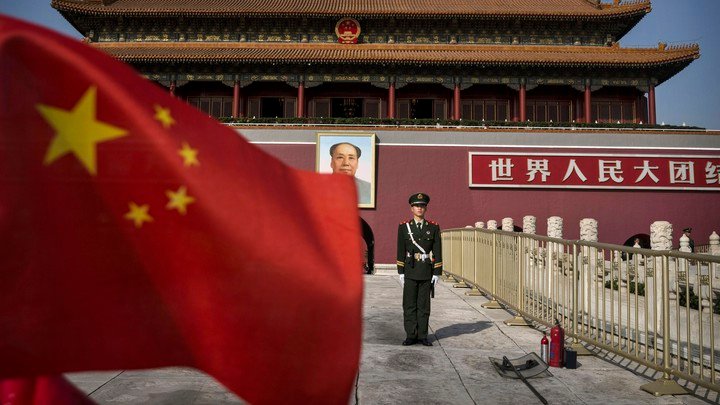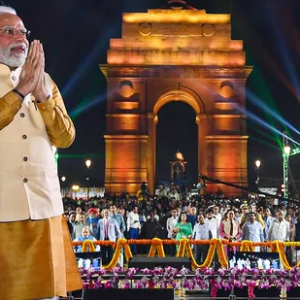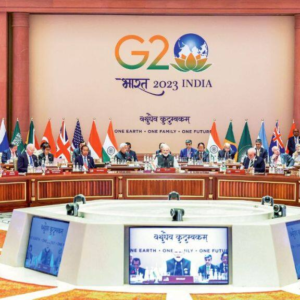It has now been over ten weeks since Kabul has fallen. This has been a tumultuous time for not just Afghanistan, but for the entire region. The takeover of Afghanistan by Taliban, which took the Biden administration by surprise due to the sheer pace of its execution, has set into motion a major geo political alignment. Afghanistan, often considered to be the graveyard of empires, may now become the epicentre of the power play between America and China. The present turmoil in Afghanistan, exacerbated by America’s messy withdrawal, presents a perfect opportunity for China to exploit the fault lines in the region and challenge the present world order.
The intense rivalry between the top two economies in the world, which first started with the trade war in 2018, has since intensified. The outbreak of coronavirus marked an inflection point in China’s relations with America and the world. It was during the pandemic that the full import of China’s wolf warrior diplomacy and its economic and foreign policy became apparent. After long speeches at Davos singing praises for multilateralism and assurances that China will not seek hegemony, the world had been taken in by Xi Jinping’s carefully crafted image of an economic super power that would not risk its trade ties for geo-political ambitions. This façade fell in 2020. For Beijing, its economic might was a means to an end. This included changing the present political world order and establishing its own system and values.
The desire to redraw world maps, which has not been restricted to just the Indo-Pacific, has led China to pursue an alternative global order, with its money power as its fulcrum. Thus, Xi Jinping forged partnerships with like-minded countries like Iran and Pakistan that share China’s deep dislike and distrust for the existing world order. These partnerships served two key objectives: to subvert the present system and undercut China’s principal rivals, which were America, India and Japan. Despite its smaller economic stature, India’s potential to be a balancing force against China in Asia, due to its demographics and rising economy, became a Chinese concern. To limit its ability to become a counter to it, China flanked New Delhi and redoubled its partnership with Pakistan. China also undercut America in its geo-strategic orbits by forming deep partnerships with countries like Iran and Russia; even as it enhanced the scope of its economic partnership with Israel.
For years, it was believed that China’s singular focus towards achieving the numero uno position in Asia would be via the maritime route, given its obsession with Taiwan and a growing desire to undo colonial subjugation under Japan, or its ‘century of humiliation’. It was assumed that China’s expansive maritime strategy, partly explaining the furious pace of ship-building since early 2010, was a precursor to sea-based hegemonic tendencies. To this effect, China built the artificial islands in the South China Sea, almost presenting a fait accompli to the United States. However, Beijing’s ambitions have not been limited to maritime expansion, but also extend to seeking expansion on land. To this effect, the Chinese Communist Party (CCP) has been actively working since 2016 to offset power equations, stretching from Pakistan till West Asia. In fact, much before Taliban’s Kabul takeover, the superpower-in-a-hurry had started laying the ground for its ambition to change status quo in the entire region. It was a message to both America and India to jettison their efforts to contain China’s expansive military strategy in Asia, which firmed up post the revival of the Quadrilateral Security Dialogue (Quad) in 2017.
Under Jinping, Beijing has been eyeing a central role in global power equations. To this effect, China has boosted its presence in a region historically considered to be America’s bastion, West Asia. Of the four Indo-Pacific democracies that formed the Quad, it was Washington and New Delhi that have been at the centre of China’s aggressive strategy for West Asia. As the final arbitrator in a region filled with inherent complexities and contradictions, America has traditionally played a pivotal role in deciding power equations. For India, the West Asian region is vital to secure its energy needs, which are heavily dependent on imports. China’s strategy to create a nexus of countries in the Middle East has rested on its ambition to challenge American power and create uncertainty for India’s oil needs. In the last one decade, China has made significant investments in the Middle East. On one end, it cultivated wide-ranging business interests with American allies like Saudi Arabia and Israel and on the other end, it redoubled efforts to deepen strategic ties with Iran.
Beijing’s Middle East roadmap had two primary facets – enhancing the scope of its partnership with Tehran and green signalling large BRI projects in Israel and Saudi Arabia, which form the backbone of the US security network in the region. This highlighted China’s hunger to target the Middle East as the next arena for its power struggle with America and the liberal world. Like Asia, where Beijing built deeper ties with Pakistan to make use of its strategic location, in the Middle East too, China used a similar template. In this region also, Beijing needed a network of allies to topple the existing world order. The end objective was creation of an alternative power axis from Pakistan to Afghanistan to Iran. In its Middle East gambit, both Russia and Turkey played an important role. In fact, Moscow was vital for Beijing to spread its influence since it hoped to piggy-ride the former’s historical connections and deep inroads across the region. So after challenging the status quo in Asia, the Middle East is now the next frontier where Beijing wants to establish itself as the new-age hegemon.
On one end was the USA-led first world order where Japan, India, France, the UK and other US allies played a key role. At the other end was a China-centric world order, sealed by the meeting of minds between two authoritarian leaders to exploit the existing fault lines in geo-politics, geo-economics and geo-technology. While the American-led system was geared towards preserving the status quo, China, along with Russia, Iran, Pakistan and Turkey, are all aligned to change the same.
The present flux in Afghanistan has further cemented China’s formation by creating a long corridor of nations that are averse to the US-dominated world order. Afghanistan, which has witnessed a shadow boxing match between two super powers in the past, is all set to witness another such geo-political contest. For almost a decade now, Beijing’s economic strength, military might and global clout have been geared for a larger objective. In fact, China’s primary goal has been to upend the world order as we knew it, one where liberal democracies with market-driven economies strive to uphold global rules. For Beijing, which became Asia’s largest economy in 2010 and the world’s second largest military spender in 2011, its economic muscle has always been a means to a larger end, which has been to create a Sino-centric world order.
A Sino-centric world order was envisaged as one where China’s primary challengers would be subverted and their prospects blunted. In Asia, this strategy resulted in Beijing firming up its partnership with Islamabad, New Delhi’s hostile neighbour to the West. China has always viewed India’s growing role in the continent’s geo-economics and geo-politics as a threat. The possibility of the latter emerging as a strategic pivot in the Indo-Pacific region and a counter-balancing force to Beijing’s aggression has spooked Communist leaders. To stymie the myriad possibilities a stronger India presented to the world in undercutting Beijing’s clout in the region, China has been pursuing an aggressive policy along its land borders. While it is now an indisputable fact that the economic trajectories of the two countries became starkly different since the early 2000s, India’s potential and ability to counter Chinese hegemony in Asia has become a growing concern for the latter. This led Beijing to solidify its economic and security cooperation with Islamabad, India’s arch rival. Of course, it helped that India was the common adversary for both China and Pakistan.
Through Islamabad, Beijing created a new geo-strategic equation, one that hurt not just India’s but also America’s security interests. To pursue its strategy to create a parallel network of allies, China made Pakistan one of the foundational pillars of its flagship investment program, the Belt and Road Initiative (BRI). Islamabad’s failed governance systems further enabled China to use its territory and resources towards its core objective. As it tied Islamabad closely to its mega BRI project by pumping in vast amounts of money in risky projects, Beijing ensured greater alignment on strategic and security issues, one of which was to contain India. As part of this policy, the BRI passed through the territory of Pakistan Occupied Kashmir (PoK) that is India’s sovereign territory. The BRI’s infrastructure projects allowed China access to vast resources in the mineral-rich but restive regions of Gilgit-Baltistan in PoK and Balochistan. In fact, while launching the China-Pakistan Economic Corridor (CPEC) under the BRI in 2015, China was brazenly contemptuous of India’s concerns. The CPEC, thus, marked an important inflection point in India’s bilateral ties with China since it undermined the former’s role in its geo-strategic orbit.
Xi Jinping’s flagship global investment drive focused on Pakistan to serve China’s economic interests and strategic ambitions. In the last two years alone, China has invested US $65 billion in Pakistan, effectively providing an economic lifeline to its defunct economy. This ensured Islamabad has continued to remain afloat, and therefore, relevant to China’s larger strategic calculations to contain India. The corridor, which is a network of highway and power projects, is worth over US $80 billion after fresh contracts worth US $11 billion were signed in 2020.[1] Out of this, Beijing’s actual investment in Pakistan was nearly US $50 billion.[2]
For Pakistan, Chinese funds were a boon since it was faced with a collapsing economy and widespread political uncertainty. Over time, as it continued to green light more projects and piled up more loans, Islamabad entered the infamous club of eight most vulnerable countries due to its very high level of indebtedness. On the other hand, for Beijing, Islamabad’s growing indebtedness was an added advantage; it translated into higher economic and political leverage over the almost-failed state. Beijing’s modus operandi was clear – exploit Pakistan’s weak economy and strategic location to circumvent India and access vital infrastructure. So, China’s reasons for pouring billions of dollars into Pakistan went beyond just economic interests. It was to flank Asia’s third largest economy. And while it used Pakistan’s locational advantage and mineral wealth, in exchange China provided complete diplomatic immunity to its acts of terror.
For China, Pakistan serves three core interests, all of which have only been reinforced since America’s withdrawal from Afghanistan that has altered the geo political dynamics. For one, Pakistani deep state has tried to ensure India remains pre-occupied with a simmering Line of Control (LoC). China’s covert and overt support to Pakistan has signalled to New Delhi about the tactical disadvantages it faces as a result of the security partnership between its two hostile neighbours. Pakistan now offers tremendous utility in stretching Indian defence capabilities by forcing it to prepare for a ‘two-front’ war scenario. As ties with China deteriorate and with Pakistan continue to remain almost-hostile, India now needs to prepare for the possibility of greater collusion between its two neighbours. This means additional strain on New Delhi’s resources. Even if the possibility of a full-blown attack remains minimal, both Islamabad and its big daddy Beijing will continue to focus on low-key attacks, which are meant to be constant irritants. The present security climate is seeing some of those possibilities coming to light, with Pakistan starting another round of killings in Kashmir and China increasing its build up around the entire Himalayan range. Post Taliban’s takeover of Afghanistan, Pakistan’s deep state will exploit its terror links further, in a bid to create more instability. This will present the Indian security establishment with continued challenges to address terrorism-related threats, both in the border union territory of Jammu and Kashmir as well as across India.
Secondly, Pakistan is also vital for China’s plans and ambitions for the Indian Ocean Region (IOR). China started developing the Gwadar port in June 2016 to gain access to the northern part of the Indian Ocean and the Persian Gulf for its military and economic ambitions. Through Gwadar, China aimed to secure access for its oil imports, which presently go through the narrow Straits of Malacca and are susceptible to disruptions. The Gwadar port, located in the troubled region of Balochistan and just 120 kilometres from the Iranian border, made China a stakeholder in a maritime region which was traditionally considered to be New Delhi’s bastion. As Beijing has been working to blunt India’s strategic advantage in this vast maritime domain, it has hoped Gwadar would serve as an ideal launch pad to gain control over maritime waters spanning Central Asia and East Africa all the way till the Straits of Malacca and beyond. The port has enhanced China’s ability to dictate rules in the larger Indo-Pacific region. Together with Djibouti in Africa, Gwadar in Pakistan and Hambantota in Sri Lanka; China has sought to develop a string of strategically located ports for maritime dominance. To counter Gwadar, India was developing the Chabahar Port in Iran’s east, which was meant to side-step Pakistan. The project, which allowed India to take the land route to Afghanistan and Central Asia, is now unlikely to take off after Taliban formed the government.
Thirdly, Pakistan provided the perfect platform and opportunity for Beijing to engage with Afghanistan – a region where China has for long envisaged an enhanced role for itself, in tandem with its growing appetite for global dominance. While India has made several efforts to reach out to Kabul, including through a generous aid program to rebuild the war-torn country, it has always been disadvantaged by Pakistan’s access, geographical proximity and close ties with the Taliban. Since Islamabad has been integral to talks, negotiations and transition of power in Afghanistan, it has frustrated Indian efforts to create a counter-balance. After Taliban’s takeover, Indian predicament have become more pronounced, even as it has further bolstered Chinese ability to engage with Afghanistan.
By exploiting the present lawlessness in Afghanistan and Taliban’s deep linkages with Pakistan, China will seek to derive maximum economic, strategic and security benefits. Increased participation by Chinese companies to rebuild Afghanistan through the flagship BRI program will translate into direct transportation links and an economic corridor between China and Afghanistan. This, by default, will undercut both Indian interests and American influence. Besides strategic interests, Afghanistan is valuable since it is home to unexplored natural resources that China covets. Access to this mineral wealth will help China to secure its long-term growth prospects.
America may have left Afghanistan, but China hopes it will fill the leadership vacuum and use it to build its alternate formation of nations. US President Joe Biden wants to prioritise the Indo-Pacific region, but there is a good chance that this is exactly what Xi Jinping also wants the US to do. It is not an either/or choice for America, and the world. Instead, China’s influence needs to be responded, both on land and on sea; both in West Asia and in the Indo-Pacific.
China’s quest to dominate the world has deep security and geo-political ramifications for India. China’s rising influence must be contained, not just in the South China Sea, but also in the Indian Ocean Region, which is New Delhi’s bastion. For India, the post pandemic altered geo-political climate has been a wake-up call for the ramifications of ceding too much space in its own backyard. Far from building on its historic relations, New Delhi has witnessed several of its neighbours been charmed by Beijing’s cheque book. China has succeeded in limiting India’s influence in countries that have deep socio-cultural ties with it. New Delhi must reclaim its place in the region, both with its neighbours on land and with the IOR littorals.
The Asia Pacific is now termed as the Indo-Pacific due to the widespread recognition of the role India must play in it. But to actualise this and regain its dominance, New Delhi needs a multi-pronged strategy. India must step up the process of rebuilding its partnerships with the littorals and enhancing engagements with its island neighbours. New Delhi has deep historical and cultural ties with the Maldives, Mauritius, Seychelles and Sri Lanka; and has for long been their natural ally. This equity must be harnessed and traditional social links with these countries must be strengthened. After years of relentless efforts by Beijing to buy influence in the IOR, New Delhi will now have to adopt bold diplomacy to reclaim lost ground. A starting point can be the lessons from Beijing-backed ‘India Out’ campaign run by opposition parties.[3] The campaign maligned India and succeeded due to India’s inability to counter such narratives early on. It deepened New Delhi’s trust deficit with Male. To gain more clout in Male’s politics, India must leverage its historical ties and engage more. Deeper defence and security ties could begin by training Maldivian defence personnel. Male’s distrust of Chinese funds after rising indebtedness can be India’s gateway to reconnect.
New Delhi’s biggest differentiator to China’s BRI-led diplomacy should be the willingness to engage with smaller countries as equal partners. India can position itself as a more ‘humane’ partner by providing solutions and aid/grant to all the island nations to address their biggest concern of ecological and environmental damage. India’s outreach coincides with the realisation by these small island nations about their geo-strategic importance, maritime value and enhanced role in the power play between India and China. To maximise their gains, the IOR littorals will even play India and China against each other as they jostle for more influence.
While China will entice them with more funds, India must step up its communication strategy to highlight the pitfalls of accepting them. New Delhi should offer attractive grants and assistance, which will be in stark contrast to China’s high interest loans. Till it becomes a US $5-6 trillion economy, New Delhi lacks the economic heft to match Beijing’s large loan book. To overcome this handicap, India must partner with Japan and the USA to provide more assistance to the IOR littorals. Tokyo has been the biggest provider of long-term infra loans in Asia, dwarfing the BRI. New Delhi must identify common areas to work with Japan in increasing development assistance to countries in IOR. India’s response to China’s debt trap model should be to create sustainable and economically viable infrastructure that boosts the local economy of recipient nations. New Delhi must communicate this message strongly to Mauritius, Seychelles, the Maldives, Sri Lanka, Comoros and Madagascar.
India’s decisive pivot for the IOR revolves around its roadmap for the strategically located Andaman and Nicobar (A&N) Islands. The northern-most point of the Andaman Islands is just 40 kilometres from Myanmar and the southern-most point of the Nicobar Islands is just 160 kilometres from Indonesia. India’s projection of power into the Western Pacific could begin from the A&N Islands which houses its first joint military command. Due to their geo-strategic location, the A&N Islands provide India an opportunity to become a key stakeholder in the IOR and SCS. At present, the A&N Islands are only geared towards reconnaissance; to boost capabilities and exploit the islands’ full potential, engagement and collaboration with other navies must be enhanced. This would be an important message for Beijing which has incorrectly assumed India to be a passive participant in the region.
So far, New Delhi had been reluctant to forge strategic partnerships with other large navies, lest it be construed as a display of intent to escalate maritime tension. But in the wake of Beijing’s regular military exercises with its partners, New Delhi’s military and foreign policy must change. Regular military drills with Pakistan, trilateral exercises with Iran and Russia in the Persian Gulf[4] and elaborate military gaming exercises with South Africa and Russia off Cape Town[5], all point towards the future direction of China’s strategy. It is to continue its efforts to encircle India. China had set its sights on the IOR in 2013, and India needs to now respond proactively. In fact, India should have started preparations for such an eventuality after December 2019 when a Chinese research vessel entered its Exclusive Economic Zone (EEZ). Research vessels are primarily used in secret military data collection and collect information that impacts the movement and efficacy of submarines.
The A&N Islands’ strategic location allows India to utilise these as an advance post to alert about any enemy vessel and must be utilised better. Despite the A&N Islands’ proximity to the Straits of Malacca, New Delhi has held back from upgrading its presence due to fears that the move would be construed as blocking a crucial choke point. But it is precisely because of their strategic location that the A&N Islands can act as a stabilising factor against China’s maritime aggression. India can deepen its presence and capabilities in the A&N Islands by collaborating with France and the USA. France, which has the second largest EEZ in the world, operates a large facility in the IOR on the French Reunion Island. Indo-French military and security ties have been upgraded under PM Modi’s tenure and New Delhi must build on this by creating advanced capabilities in the A&N.
In any military strategy, not knowing the adversary’s larger ambition or game plan is the biggest surprise factor. In China’ case, though, there are no surprises; its over reach and ambition is clear. What remains unclear is the roadmap to address it.
Author Brief Bio: Gaurie Dwivedi is a Senior Journalist covering economy, policy and politics. She is also Visiting Fellow at USI.
References:
[1] Muhammad Akbar Notezai, ‘CPEC 2.0: Full Speed Ahead’, 2020, https:// thediplomat.com/2020/09/cpec-2-0-full-speed-ahead/
[2] American Enterprise Institute, China Global Investment Tracker, https:// www.aei.org/china-global-investment-tracker/
[3] N Sathiya Moorthy, ORF, July 2021, https://www.orfonline.org/expert-speak/maldives-india-out-campaign-now-takes-a-personal-turn-with-local-political-implications/
[4] N Bozorgmehr, H.Foy, Financial Times, December 2019, https://www.ft.com/content/3d5a4cf0-288f-11ea-9a4f-963f0ec7e134
[5] Ankit Panda, The Diplomat, Nov 2019, https://thediplomat.com/2019/11/chinese-russian-south-african-navies-conduct-trilateral-naval-exercises/




